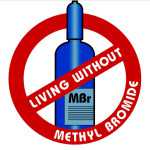Success Sans Methyl Bromide Could Prove Costly
 In agriculture, we invest in producing a crop where we often do not know the returns until months or even years after the current operations begin. Some investments like citrus take years of investment and returns before we know what impact it has on our wealth. The produce industry has long been characterized as a high-risk enterprise. We can spend thousands of dollars per acre to grow a crop and history tells us we have opportunity for rich rewards and measurable probability or complete failure.
In agriculture, we invest in producing a crop where we often do not know the returns until months or even years after the current operations begin. Some investments like citrus take years of investment and returns before we know what impact it has on our wealth. The produce industry has long been characterized as a high-risk enterprise. We can spend thousands of dollars per acre to grow a crop and history tells us we have opportunity for rich rewards and measurable probability or complete failure.
Vegetable growers face increased peril with the loss of methyl bromide. Growers operated for years with methyl bromide as a soil fumigant that served as a broad-spectrum control for pests and diseases. Because it was identified as a potential ozone-depleting substance, it has been phased out of use for most crops grown in Florida. Research has been a priority for identifying alternative control practices, but nothing has yet been identified that provides the control that methyl bromide provided.
Some science suggests we are close to (or have achieved) a sustainable alternative for many crops, but what we often fail to factor in is the increased risk that the alternatives add.
The greatest risk to producing fresh vegetables when methyl bromide was applied came from weather or an oversupplied market. They now contend that alternatives to methyl bromide provide the same expected outcomes as those crops produced with methyl bromide, but what they fail to recognize is the increased probability of lower yields or total crop failure.
Facts And Figures
To highlight the impacts of increased risk, consider two investment scenarios: (1) an investment that provides a 60% chance of returning a $1,000 profit per acre, a 35% chance of losing $1,000 per acre, and a 5% chance of losing $11,000 per acre (the crop); or (2) an investment that provides a 55% chance of returning $1,000 per acre in profit, a 30% chance of losing $1,000 per acre, and a 15% chance of losing $11,000 per acre.
The first scenario has an expected outcome of $0 (multiplying probabilities by the expected profits and summing). The second scenario has an expected loss of $1,125 per acre. The difference in the scenarios lies only in the increased probability of losing $11,000 per acre, taken equally from the probability of profit and the probability of normal loss without disaster.
Alternative Avenues
Methyl bromide alternatives work for production agriculture if you ignore the increased risk of disaster. A successful crop produced without methyl bromide probably looks like the same crop produced with methyl bromide. But the probability of a successful crop without methyl bromide is lower than the probability of a successful crop with it. We are currently evaluating those probabilities. Our hypothesis is that the phase-out of methyl bromide, with adoption of alternatives currently available in Florida, will have results similar to the above example. If so, we will need to advance the science to change those probabilities — increasing the likelihood of a successful crop without methyl bromide. There is still work to do to mitigate the impact of losing methyl bromide as a soil fumigant.










